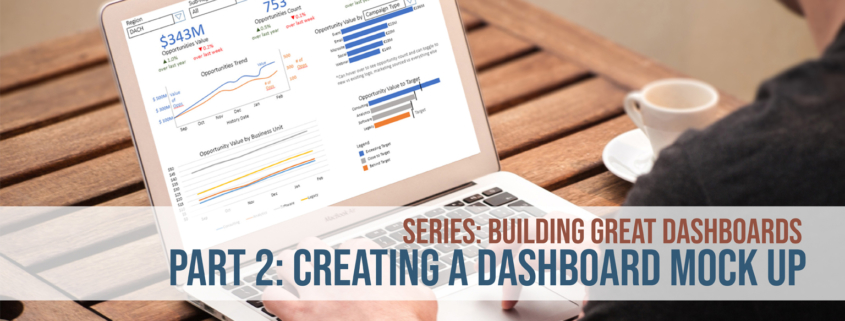Part 2: Creating a Dashboard Mock-Up
Building Great Dashboards Series
Part 2: Creating a Dashboard Mock-up
This is part two of our four-part series on building great dashboards. If you have not read Part 1: Gathering Dashboard Requirements, you may want to go back and start there.
In our previous blog post, we described how to have a productive requirements gathering meeting, that allows you to know what stakeholders want out of the dashboards. For the next step you may be tempted to jump right into Tableau, Power BI, or your dashboard tool of choice but we recommend building a mock-up of the dashboard. This mock-up is just an image or a visual of what the dashboard will look like. If you have graphic design skills or a graphic designer on your team, then you can use a tool like Adobe InDesign to build the mock-up. Otherwise, PowerPoint or even a piece of paper will work just fine. The goal is not to build a mock-up that will look exactly like the final product – just something close enough to share with end users for discussion and feedback.
Click here for an example mock-up created in PowerPoint.
Now that you have the basic idea of what the mock-up is, let’s dive into why you should use it and how to build one.
Why should I build a mock-up dashboard?
After your requirements meeting, there are probably a lot of directions you can go in to answer the high-priority questions that you gathered from the team. Before you begin using a dashboard tool like Tableau or Power BI, you need to build a data set, and how you build that data set will be based on what the final dashboards will look like. In reality, you could spend weeks building a data set and initial dashboard, only for key users to request something completely different. Enter the mock-up. A mock-up is a very quick way to get a visual and your plan in front of the key users so everyone can agree at a high-level on how the dashboards will look and function.
How do I build a mock-up dashboard?
It can be intimidating staring at a blank computer screen trying to decide what to create. Below are a few ways to help you get started.
Look for inspiration
There are many resources that show dashboards created by other people that can help get that creativity flowing. Tableau shares a Viz of the Day from its public gallery. The Big Book of Dashboards provides examples of dashboards for specific business challenges and scenario solutions. If your organization already has a library of high-quality dashboards, then you can look at those for inspiration as well.
A tip from our data scientists: Whenever you see a dashboard you like, save a copy of the image to a folder, so you can scroll through them all when it is time to create a mock-up.
Get a team together
Don’t feel like you have to do it alone! If there are other analysts at your organization, even if they are not on your team or working on this project, ask them if they will help you to build a mock-up. You can briefly describe the key questions, and they can quickly sketch an idea. It does not take much time, and it may end up inspiring the final design.
Crazy Eights
Crazy eights is a design exercise to help you quickly come up with multiple mock-up solutions. You can do it by yourself, or in a group. Just take a regular piece of letter-sized paper and fold it so that there are eight separate rectangles on it. Set a timer for eight minutes, and start sketching out a different dashboard design in each rectangle. Keep it real quick and dirty. For each box, spend about a minute trying try to come up with a totally different view for the dashboard. You may find this difficult after the third or fourth one, but do your best to try to get to eight. Do not worry if your views start to get outlandish, just keep trying to come up with new ideas. Once you are done, you can try to pull the best ideas from each sketch to build a final mock-up.
Share with the stakeholders
Once you have built a mock-up, it is time to go back to your key stakeholders and get their feedback on the mock-up. This is best done in a live meeting, but if it is hard to get everyone together at the same time, it can be done via email. If you send around a PDF, the team can add comments and notes directly in the file for feedback.
After collecting feedback from the team, you are in a really great place to build the data set and start building dashboards. Watch out for an upcoming post on Part 3: Soliciting Feedback While Building a Dashboard.



